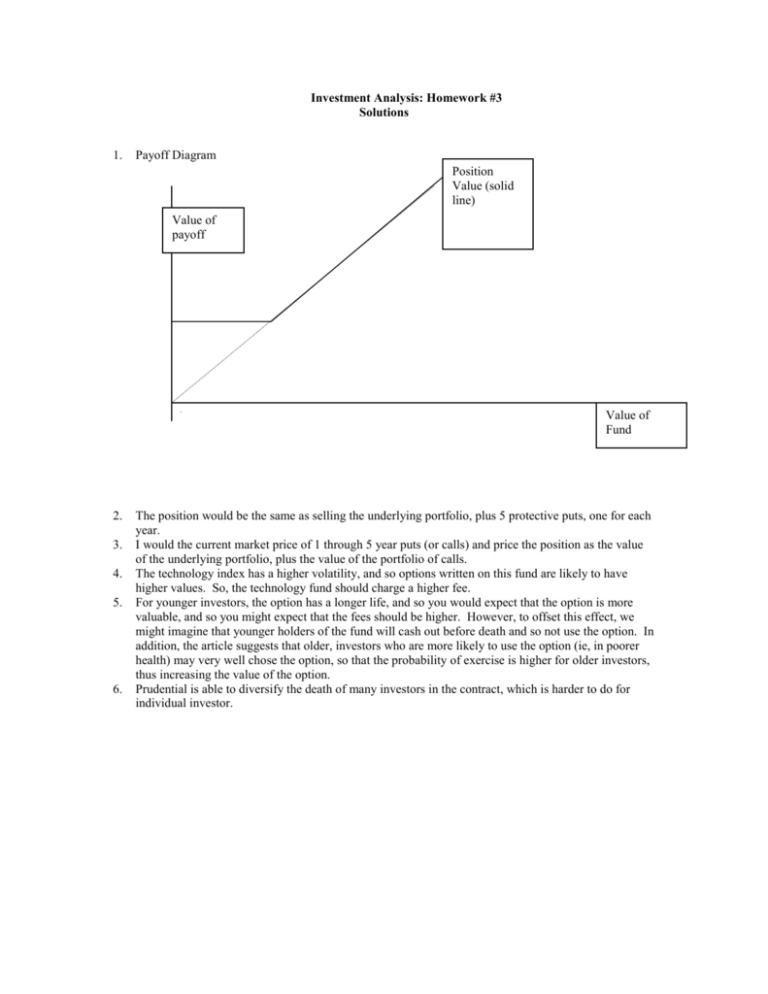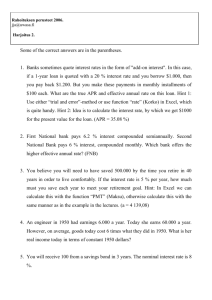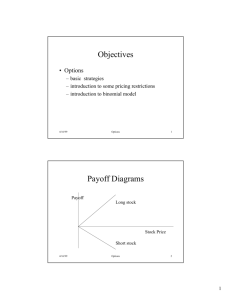Investment Analysis: Homework #3 Solutions 1. Payoff Diagram 2
advertisement

Investment Analysis: Homework #3 Solutions 1. Payoff Diagram Position Value (solid line) Value of payoff Value of Fund 2. 3. 4. 5. 6. The position would be the same as selling the underlying portfolio, plus 5 protective puts, one for each year. I would the current market price of 1 through 5 year puts (or calls) and price the position as the value of the underlying portfolio, plus the value of the portfolio of calls. The technology index has a higher volatility, and so options written on this fund are likely to have higher values. So, the technology fund should charge a higher fee. For younger investors, the option has a longer life, and so you would expect that the option is more valuable, and so you might expect that the fees should be higher. However, to offset this effect, we might imagine that younger holders of the fund will cash out before death and so not use the option. In addition, the article suggests that older, investors who are more likely to use the option (ie, in poorer health) may very well chose the option, so that the probability of exercise is higher for older investors, thus increasing the value of the option. Prudential is able to diversify the death of many investors in the contract, which is harder to do for individual investor. 7. Payoffs underlying Net position (solid) Long put Short call 8. The executive’s position consist of going long the underlying shares (his executive stock holdings), purchase at put option at exercise price X and sell a call option at exercise price Z > X. Put-call parity says that a call minus a put gives the same payoff as a stock minus a bond, or C(X)-P(X)=S-X/R. So, we can say that the payoff of a put is equal to the payoff on a call with the same strike price less the underlying shares plus a bond. Substituting this into the call portion of the executives payoffs, we have that the payoff is given by: S+[C(X)-S+X/R]-C(Z), or simplifying, the payoff is given by C(X)+X/R-C(Z). That is, using calls, the payoff is equivalent to purchasing a bond with a final payoff of X, going long a call option with exercise price X and shorting a call option with exercise price Z > X.. We can also use put call parity to substitute out the call payoff in terms of put payoffs. The call is equal to going long the underlying security, short a bond with final payment equal to the exercise price, and shorting the put. Substituting this into manager’s position, S+P(X)-C(Z)=S+P(X)-[SZ/R+P(Z)]=P(X)-P(Z)-Z/R, or going long the put with exercise price X, shorting the put with exercise price Z, and shorting a bond with a final payment of Z. 9 The process for the share price and put options is given in the following tree Stock Price Put Value 144 max(100-144,0)=0 120 Pu 100 100 83.33 Po 0 30.66 We will now solve for the value of the put option. It is probably easier to develop the general method at this point, and then apply it to our specific situation. So, suppose that the current price of the underlying stock is given by S. The binomial assumption means that next period, the stock will either be dS or uS. Suppose that we want to replicate the payoff X after the u move and Y after the d move. Letting α be the number of shares to hold and β the bonds, the equations to solve for replication are: State u: α(uS) +β=X State d: α(dS) +β=Y. This system of equations can be solved to give: α=(X-Y)(uS-dS) β=X-(X-Y)u/(u-d), and the value of the replicating position is given by αS+β/R=(X-Y)/(u-d) + (1/R)(X-(X-Y)u/(u-d)), which can be simplified to (1/R)[X((R-d)/(u-d))+Y((u-R)/(u-d))]. We can now apply these formulas to the value of the put option. Here is a copy of the calculations that I did using a spreadsheet to do the valuation. I will post the spreadsheet on the course web page.: U 1.2 D 0.83 R 1.1 (R-d)/(u-d) 0.7272727 (u-R)/(u-d) 0.2727273 Strike 100 Stock Price Put Tree 144 120 100 Replicating Positions 0 State Stock 0 100 1.878287 83.333333 0u 0 d -1 7.5757576 69.444444 So, the put currently has a value of 1.88. bond Value 0 -0.2066116 24.793388 30.555556 0 1.878287 0 100 7.5757576 10. To figure out the call that must be sold to pay for the put, I set up a similar spreadsheet to the above, and used the solver to find the exercise price that makes the value of the call equal to 1.88. Call Valuation Exercise price 139.70312 Call tree replicating position 4.2968773 State Stock 2.8409106 1.878288 0 0u 0 d bond 0.0774794 value -6.456615 1.878288 0.0976563 -9.7656302 2.8409106 0 0 0 0 Difference 1E-06 11. We can combine the results from put and call valuations above to come up with the hedge. Here are the total positions: State Stock Bond 0 -0.12913 18.33677 u 0.097656 -9.76563 d -1 100





